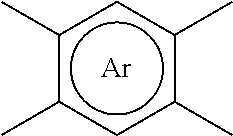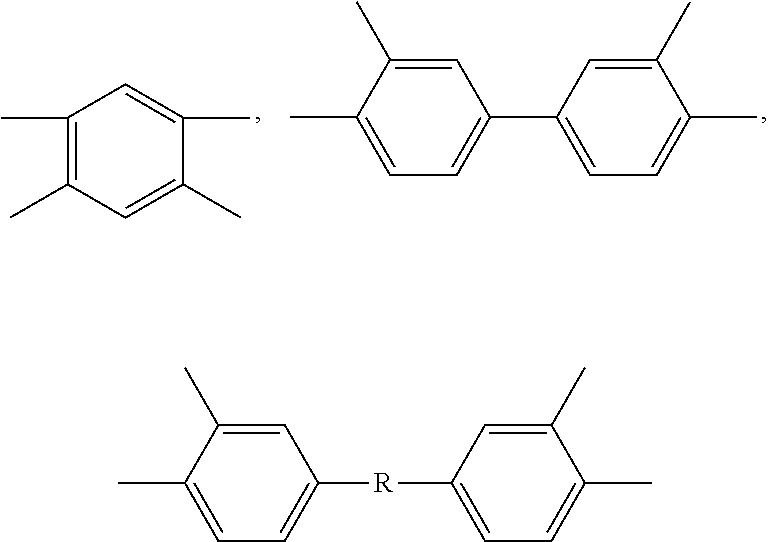Method to improve the selectivity of polybenzoxazole membranes
a polybenzoxazole and selectivity technology, applied in the field of improving the selectivity of polybenzoxazole membranes, can solve the problems of thermal stability and contaminant resistance limitations of traditional polymer membranes, and the inability to meet the requirements of a wide range of applications. achieve the effect of improving the selectivity of co2/ch4 and h2/ch4, high mechanical stability, and easy processability
- Summary
- Abstract
- Description
- Claims
- Application Information
AI Technical Summary
Benefits of technology
Problems solved by technology
Method used
Image
Examples
example 1
Preparation of Poly(6FDA-HAB) / Poly(BTDA-APAF-HAB) Blend Polymer Membrane
[0052]A poly(6FDA-HAB) / poly(BTDA-APAF-HAB) blend polymer membrane was prepared from poly(6FDA-HAB) and poly(BTDA-APAF-HAB) polymers with 1:1 weight ratio. The poly(6FDA-HAB) polymer was synthesized from 2,2′-bis-(3,4-dicarboxyphenyl) hexafluoropropane dianhydride and 3,3′-dihydroxy-4,4′-diamino-biphenyl via a polycondensation reaction. The poly(BTDA-APAF-HAB) polymer was synthesized from 3,3′,4,4′-benzophenonetetracarboxylic dianhydride, 2,2-bis(3-amino-4-hydroxyphenyl)-hexafluoropropane, and 3,3′-dihydroxy-4,4′-diamino-biphenyl via a polycondensation reaction. A molar ratio of 3,3′,4,4′-benzophenonetetracarboxylic dianhydride, 2,2-bis(3-amino-4-hydroxyphenyl)-hexafluoropropane, and 3,3′-dihydroxy-4,4′-diamino-biphenyl is 3:2:1. 2.5 g of poly(6FDA-HAB) and 2.5 g of poly(BTDA-APAF-HAB) were dissolved in a solvent mixture of 16.0 g of NMP and 9.0 g of 1,3-dioxolane. The mixture was mechanically stirred for 2 hours...
example 2
Preparation of Poly(6FDA-HAB) / Poly(BTDA-APAF-HAB) Blend Polymer Membrane Containing Poly(Styrene Sulfonic Acid) Polymer
[0053]A poly(6FDA-HAB) / poly(BTDA-APAF-HAB) blend polymer membrane containing poly(styrene sulfonic acid) polymer was prepared as follows: 1.25 g of poly(6FDA-HAB) and 1.25 g of poly(BTDA-APAF-HAB) were dissolved in a solvent mixture of 8.0 g of NMP and 4.5 g of 1,3-dioxolane. The mixture was mechanically stirred for 2 hours to form a homogeneous casting dope. Then 0.2 g of poly(styrene sulfonic acid) polymer was added to the casting dope under stirring. The casting dope was stirred for another 1 hour. The resulting homogeneous casting dope was allowed to degas overnight. The poly(6FDA-HAB) / poly(BTDA-APAF-HAB) blend polymer membrane containing poly(styrene sulfonic acid) polymer was prepared from a bubble free casting dope on a clean glass plate using a doctor knife with a 20-mil gap. The membrane together with the glass plate was then put into a vacuum oven. The sol...
example 3
Preparation of Polybenzoxazole Polymer Membrane PBO (6FDA-HAB / BTDA-APAF-HAB)-350
[0054]The polybenzoxazole polymer membrane PBO(6FDA-HAB / BTDA-APAF-HAB)-350 was prepared by thermally heating the PI(6FDA-HAB / BTDA-APAF-HAB) polymer membrane prepared in Example 1 from 50° to 350° C. at a heating rate of 3° C. / min under N2 flow. The membrane was held for 1 hour at 350° C. and then cooled down to 50° C. at a heating rate of 3° C. / min under N2 flow.
PUM
| Property | Measurement | Unit |
|---|---|---|
| temperature | aaaaa | aaaaa |
| temperature | aaaaa | aaaaa |
| time | aaaaa | aaaaa |
Abstract
Description
Claims
Application Information
 Login to View More
Login to View More - R&D
- Intellectual Property
- Life Sciences
- Materials
- Tech Scout
- Unparalleled Data Quality
- Higher Quality Content
- 60% Fewer Hallucinations
Browse by: Latest US Patents, China's latest patents, Technical Efficacy Thesaurus, Application Domain, Technology Topic, Popular Technical Reports.
© 2025 PatSnap. All rights reserved.Legal|Privacy policy|Modern Slavery Act Transparency Statement|Sitemap|About US| Contact US: help@patsnap.com



